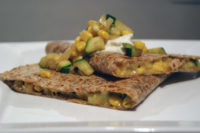
Double Play
Stats
12 pizzas per case
330 cases per hour
10,000-12,000 cases
500-lb. batches of dough
10-12 minutes at 0°F
30 years of growth
Two plants are better than one for Richelieu Foods, Inc., whose Ohio and Wisconsin facilities work in conjunction to create the manufacturer’s fresh-tasting frozen pizzas.
Because Richelieu Foods, Inc. goes to bat for its customers, they know what to expect in terms of production from this perennial all-star in the frozen pizza category. Just look at its runs — 12 pizzas per case, 330 cases per hour and 10,000-12,000 cases per day.
But for Richelieu, these numbers are more than just stats. They reflect the pizza maker’s performance on any given day … and 30 years of growth and success in the frozen pizza category.
The Braintree, Mass.-based manufacturer, which began producing pizza in 1978 as a Jewel store commissary, owns three plants, two of which focus almost exclusively on the production of its private label, contract-packaged and branded pizzas. Each facility also is certified organic by the United States Department of Agriculture, giving Richelieu twice the power of ordinary pizza pie producers.
The manufacturer’s crusts range from thin, extra thin and brick oven-style to self-rising and an 8x8-in.-square Sicilian-style, and have various edges, including natural, raised, deep dish lip and band-sawed. They are stamped out using a unique cold press process at the company’s facility in Washington Court House, Ohio. This method is reminiscent of the way pizza crusts originally were made, as opposed to the hot press technique that many pizza makers use, says Neil Whitman, vice president of research and development, quality assurance.
Richelieu starts with 500-lb. batches of dough — produced from organic, conventional or whole wheat flour — that are mixed and then divided into small balls before being rounded and dropped into an ambient bucket for three minutes. Next, the balls are coated in vegetable oil and pressed into pans that have cavities with specific dimensions for the type of crust being produced. No heat is applied to the presses or pans, hence the term “cold press,” Whitman says.
The pans then travel through a spiral proofer that’s maintained at 115°F at 90% relative humidity for about 12 minutes, causing the dough to rise.
After proofing, the crusts are baked in a 150-ft. tunnel, gas-fired oven and then cooled in a spiral refrigerator. Each crust passes through a metal detector before it’s packed into a poly bag and corrugated shipping case and is checked for proper dimensions, weight, thickness and moisture.
The finished crusts either are refrigerated or frozen and shipped almost daily to Richelieu’s Beaver Dam, Wis., plant, where they are topped, frozen and packaged, notes Vincent Fantegrossi, president and chief executive officer.
Richelieu’s Wisconsin plant houses three lines in different configurations, including a side-by-side 2-up line and a flexible, specialty, single-file 1-up line that’s used to maximize throughput with fewer and quicker changeovers.
Last August, Richelieu implemented a third line that is geared toward producing pizzas sold in boxes. Every carton can contain from one to three individually packaged pizzas.
On each line, crusts are first hand-fed into a conveyor. Sauce is then pumped through stainless steel tubes and automatically deposited on the crusts, which next are covered with pre-cooked ingredients, such as sausage and diced or sliced pepperoni, followed by cheese that’s freshly shredded by workers inside the plant. Vegetables always are the last ingredients applied, sometimes even by hand for specialty items, Fantegrossi says.
The finished product is fed into a spiral freezer — rather than stored in mechanical freezers — where liquid nitrogen is used to cryogenically freeze the pizzas in 10-12 minutes. This means less maintenance and equipment for the manufacturer.
Frozen pizzas are packaged one of two ways, depending on the product and the line. Cardboard is either placed under the pizza before it’s covered in an overwrap film and heat-sealed around the edges, or the pizzas are placed on the in-feed of a wrapper, where film forms around the product, sealing it on the bottom for a shrink-wrapped result.
At the end of each line is a process control station where the pizza’s temperature and weight are checked and recorded. All products are again metal-detected for safety. Additionally, employees hand-inspect the pizzas to make sure they are properly sealed.
Last, but not least, the pizzas are case-packed, palletized and warehoused in a pallet-store freezer at 0°F.
Richelieu’s flexible configurations, quality control methods and interest in customer service give it various advantages over the competition. As a private label manufacturer, it has the additional benefit of being able to build custom orders for its clients.
“For one customer, we even split the case and put in multiple flavors,” Fantegrossi says. “We’re fairly close to made to order.”
In addition, “a lot of our retail partners rely on us to assist them in the packaging area, not only in design, but in finding them ways to become even more competitive, whether it’s modifying equipment, standardizing pack sizes or coming up with a novel package,” notes Henk Hartong, Richelieu chairman.
Because Richelieu combines automated technology with manual labor, “the quality of the workforce is important to our success,” adds general manager James N. Campbell.
It’s no wonder Richelieu’s products are scoring with supermarket shoppers. Between its innovative and organic offerings, its burgeoning private label business and the growth of its Chef Antonio brand (see “Survival of the Freshest” for details), Richelieu has become not just a double, but a triple threat in today’s competitive frozen pizza category. SF&WB

